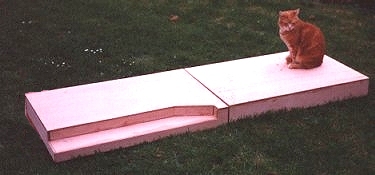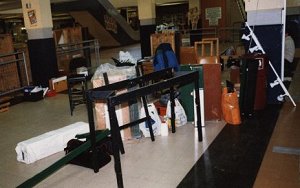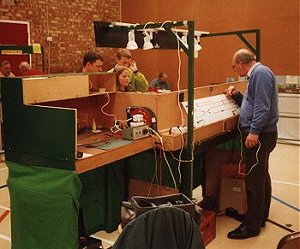 Since neither of us
is particularly good at woodwork the baseboards were cut out of 9mm thick plywood by a local DIY store. This left us with a baseboard kit that just needed a cut-out making for the water and then glueing and pinning together.
Since neither of us
is particularly good at woodwork the baseboards were cut out of 9mm thick plywood by a local DIY store. This left us with a baseboard kit that just needed a cut-out making for the water and then glueing and pinning together.Melbridge Dock
Construction
 Since neither of us
is particularly good at woodwork the baseboards were cut out of 9mm thick plywood by a local DIY store. This left us with a baseboard kit that just needed a cut-out making for the water and then glueing and pinning together.
Since neither of us
is particularly good at woodwork the baseboards were cut out of 9mm thick plywood by a local DIY store. This left us with a baseboard kit that just needed a cut-out making for the water and then glueing and pinning together.
On the right you can see the raw boards for the scenic section. A fiddle yard was added to the right and a twelve inch high plywood backscene 6 inches in from the back. No underboard strengthening was necessary as each board is only 3 feet long. The two scenic boards are bolted, with flat end boards, to face each other forming a box for transit. The completed package can (just) be managed by one person in and out of vehicles and for short moves.
At shows the boards are joined with a pair of demountable hinges. We simply but the boards up and drop the pins in. This also takes care of track alignment and has been used on all our subsequent layouts including Flockburgh which is finescale 3mm.
 The layout splits into 3 boards, 2 scenic and one fiddle yard. The fiddle yard is offset as the track onto it is too near the front edge of the board to allow a three way point to fit on any other way. The three way allows one man operation without the operator having to move into the fiddle yard to change trains.
The layout splits into 3 boards, 2 scenic and one fiddle yard. The fiddle yard is offset as the track onto it is too near the front edge of the board to allow a three way point to fit on any other way. The three way allows one man operation without the operator having to move into the fiddle yard to change trains.
Support is provided by a leg system best described as a pair of goalposts joined by a hinged beam at each end. These are spread, a couple of furniture "chocolate block" joiners have their bolts inserted and then the layout goes on top. On packing up, the legs go into the car first and fit neatly around the edge - everything goes inside. Our original trestle based system took up much more space in the car ! To steady things up the end packing boards fit between the legs.
Since you can never rely on decent lighting at a venue we bring our own. Two pairs of IKEA spotlights are supported over the front by a couple of simple gallows. To finish things off a fascia board bolts on to the front of this. I discovered the hard way that setting this up properly is vital. At our last NEC appearance the light were set too low, just in my field of vision. The crashing headache I left with made sure that subsequently I screw things together properly ! Standard bulbs are used - we tried daylight balanced ones which looked lovely but light spill from the rest of the hall negated the effect. Consequently we've reverted to something cheaper and easier to replace if we run out of spares over a weekend.
On the front a pair of information boards host photographs and information on the prototype. They also give us some useful barriers if the show doesn't provide them. Finally, a display box on the fiddle yard holds locomotives not in use at the time. People seem to enjoy looking at the stock and this saves them having peer into the yard and see all the mess !
Sadly, all this extra display meant that the model won't fit in a twenty year old Ford Fiesta. A Peugeot 306, Citroen Berlingo or VW Campervan are OK though.
 From the back you can see all our
From the back you can see all our mess secrets. Control is from a Gaugemaster hand held controller (no DCC for us !) and point operation is though a mimic panel made up from "go-faster stripe" from a car accessory shop. In this are mounted cheap push to make switches for point operation (more on point operation on my blog).
Point motors are Peco with an accesory switch to change frog polarity and an adaptor base to allow sub-baseboard mounting. Many are as old as the layout and still work well. Power comes via a Modelex heavy duty CDU.
Two transformers are used. The track gets 16V from a Guagemaster unit. A seperate supply from a H&M transformer that must be at least thirty years old runs the points.